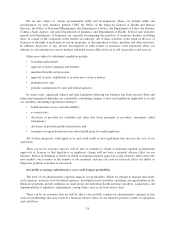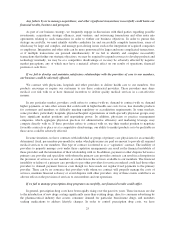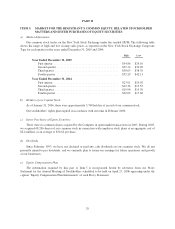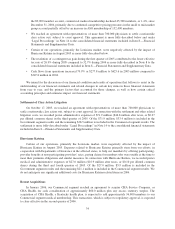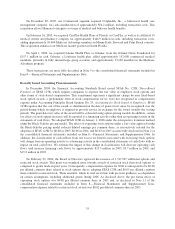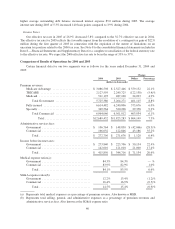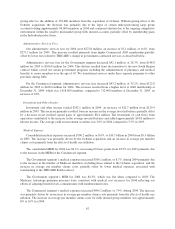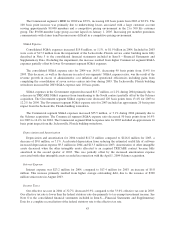Humana 2005 Annual Report Download - page 43
Download and view the complete annual report
Please find page 43 of the 2005 Humana annual report below. You can navigate through the pages in the report by either clicking on the pages listed below, or by using the keyword search tool below to find specific information within the annual report.In our TRICARE business, 2005 marked our first full fiscal year under the South Region contract. After
being awarded the South Region contract in 2003, we transitioned our TRICARE business to one of three newly-
created regions under the government’s revised TRICARE program during 2004. We started the second option
year under the South Region contract on April 1, 2005.
Commercial Segment
Our strategy to drive Commercial segment profitability focuses on providing solutions for employers to the
rising cost of health care through the use of a variety of innovative and consumer-choice product designs. These
products are supported by electronic informational capabilities, including education, tools, and technologies
provided primarily through the Internet. To that end, we have developed an innovative suite of products styled as
“Smart” products. We believe that these Smart products offer the best solution for many employers to the
problem of quickly rising health care costs for their employees. Membership in our Smart products and other
consumer-choice health plans increased to 371,100 members at December 31, 2005, a 52% increase from
December 31, 2004. We believe that growth in these products, which are offered both on a fully insured and
ASO basis and competitively priced to produce higher margins, is a key component, among other items, for
further improvement in the results of our Commercial segment. Additionally, we have increased the
diversification of our commercial membership base, not only through our consumer-choice products, but also by
(1) expanding our ASO membership in the mid-market group segment to take advantage of our network
discounts and (2) launching our HumanaOne individual product to address an increasing migration of insureds
from small group. While we expect our consumer-choice products to become a driver of growth in the years
ahead as health care inflation persists, we also are enhancing the traditional products which comprise the bulk of
our commercial portfolio today by applying our consumer-choice innovation.
Other important factors which impact our Commercial segment profitability are both the competitive pricing
environment and market conditions. With respect to pricing, there is a tradeoff between sustaining or increasing
underwriting margins versus increasing or decreasing enrollment. We have experienced a decline in our fully
insured commercial membership as a result of pricing actions by some competitors who we perceive as desiring
to gain market share in certain markets. With respect to market conditions, we are impacted by economies of
scale on administrative overhead. As a result of a decline in preference for tightly-managed HMO products,
medical costs have become increasingly comparable among our larger competitors. Product design and consumer
involvement have become more important drivers of medical services consumption, and administrative expense
efficiency is becoming a more significant driver of commercial margin sustainability. Consequently, we
continually evaluate our administrative expense structure and realize administrative expense savings through
productivity gains. Additionally, because our Commercial segment shares overhead costs with our Government
segment, an increase or decrease in the size of our Government operations impacts our Commercial segment
profitability.
Highlights
• In the Government segment, CMS approved all the 2006 Medicare contracts we applied for, giving us a
wide array of products to sell and increasing the number of states where we sell them.
• Our Commercial segment reached an agreement to acquire CHA Service Company and completed the
acquisition of Corphealth, Inc. Our Government segment completed the acquisition of CarePlus Health
Plans of Florida. These transactions are more fully-described on the following page and in Note 3 to the
consolidated financial statements included in Item 8.—Financial Statements and Supplementary Data.
• Membership in Medicare Advantage products grew by 180,600 members, or 47.9%, from December 31,
2004, including 130,200 members from sales primarily related to our new PFFS offering, and 50,400
members from the acquisition of CarePlus Health Plans of Florida.
• Commercial medical membership declined by 134,300 members, or 4.1%, from December 31, 2004,
including the loss of an 89,000 member unprofitable account that lapsed on January 1, 2005. Excluding
33



